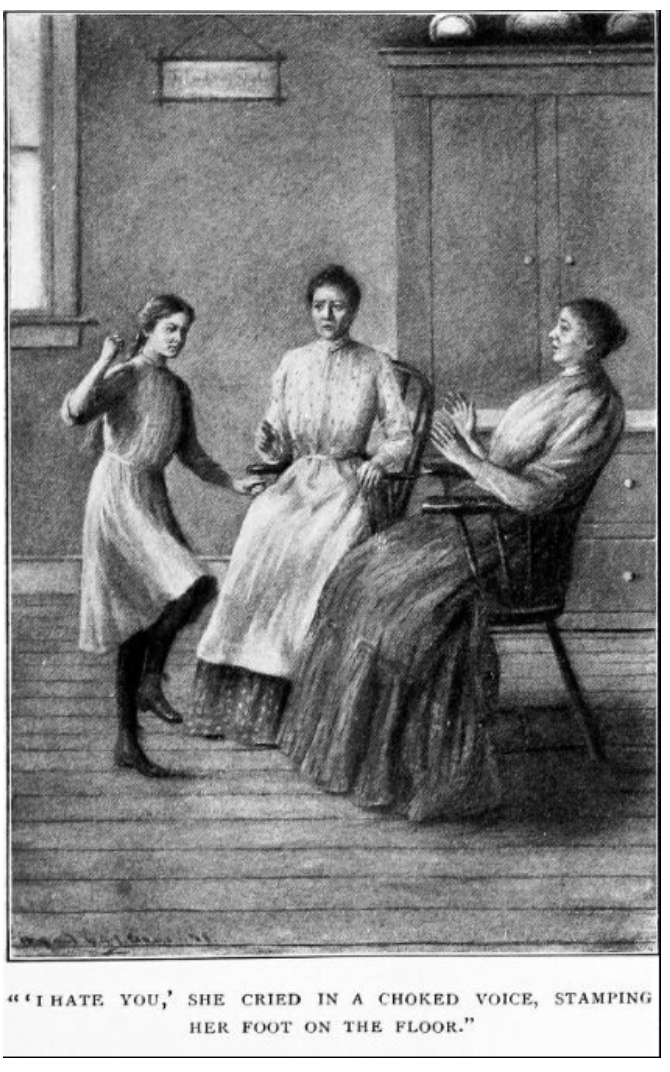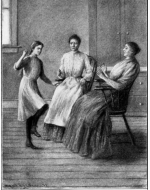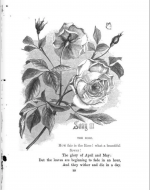Created by Sylvie Novak on Sun, 02/28/2021 - 17:09
Description:
Canadian Lucy Maud Montgomery has long been considered a standout author for her contributions to children’s literature. Anne of Green Gables (1908), one of her most well-known books, is a tale that bridges the divide between traditional didacticism and entertainment for children. With its witty morals and comforting dialogue, this classic remains alive in the hearts and minds of all of its readers. The audience follows the growth of Anne, a bright eyed and widely beloved girl, who throughout her childhood and young adulthood, faces tragedy and triumph. Through her mishaps as she matures, we are alerted to a new form of children’s literature that reworks didacticism and transforms mistakes into amusing scenes, breaking down the didactic stronghold on childhood experiences. As Anne of Green Gables has entered popular culture, the shift towards entertainment has been made more obvious. What started as a novel by Montgomery has been refashioned into movies, picture books, and reenactments that abandon even a hint of these out-of-fashion didactic morals.
M.A. and W.A.J. Claus, "'I Hate You,' She Cried in a Choked Voice, Stamping Her Foot on the Floor," from Anne of Green Gables (1908), by Lucy Maud Montgomery.
This first plate touches upon what could be seen, in the Victorian era, as Anne committing "sinful" behavior. This illustration, appearing in Chapter 9 of Montgomery's well-known tale, represents Anne's fiery tantrum following Mrs. Rachel Lynde's harsh criticism of her red hair and numerous freckles. Montgomery is quite revolutionary in this depiction of Anne. While early didactic authors such as Isaac Watts prompt children to be deferential towards adults and treat their word as law, Montgomery goes against this notion by having Anne behave as we expect a typical child would in that situation. She does not have Anne hold back as she tells Mrs. Lynde off, allowing her to question Mrs. Lynde about how she would feel were she in Anne's shoes. While Anne is punished for her behavior towards Mrs. Rachel Lynde, her punishment is far more humane than what she would have faced if she had misbehaved in a didactic text. When Marilla orders Anne to apologize and Anne subsequently abides by Marilla's request, that is the extent of the consequences of Anne's rudeness. Montgomery does not enforce the world of children burning for their misdeeds, as is depicted in tales such as "The Dreadful Story About Harriet and the Matches," written by Heinrich Hoffmann and found in The English Struwwelpeter. In this didactic story, originally published in German in 1845 and then translated to English in 1848, a girl named Harriet has disobeyed her mother and nurse who forbade her to light a box of matches. Harriet is soon punished for her disobedience with terrifying consequences. Her apron-string catches on fire from a lit match, and she begins to burn, presumably to death. These forms of horrific punishment, while widely accepted in the didactic era of children's literature, are avoided by Montgomery, who instead of having Anne catch aflame, introduces a real-world solution to a real-world situation, forming a more pleasant narrative than that of early didactic texts.
T. Kennedy, "The Full-blown Rose," for "Song III. The Rose," for Divine and Moral Songs for Children (1715), by Isaac Watts, 1866 edition.
The second plate is the first page of "The Rose," found in Divine and Moral Songs for Children. In this didactic song, Isaac Watts guides his young audience away from vanity and suggests that children should instead strive to be good people who try their best to be successful in their duties. He writes that by going against vain urges, children will earn respect and admiration in their adulthood and even after they pass away. Watts chooses a rose to depict this principle because beautiful flowers soon wilt and represent fading beauty as they die. This song stands in sharp contrast to the following image of Anne, who proudly wears her flowered hat to her Sunday School. Anne does not mind that these flowers may soon wilt, because to her, their beauty in that moment is unsurpassable. The flowers crowning her head offer Anne unbridled joy. Montgomery and the Clauses directly challenge Watts in the following illustration and scene by going against the didactic view of “vanity” and choosing to have Anne feel beautiful without negative consequences.
M.A. and W.A.J. Claus, "They Looked at Her and Whispered to Each Other," from Anne of Green Gables (1908), by Lucy Maud Montgomery.
The third plate depicts Anne walking boldly into Sunday School. Her hat, once plain, is now adorned with a variety of freshly picked wild roses and buttercups. This scene introduces an entertaining element to the story that would have been missing in early 19th century didactic tales and songs, including "The Rose," referenced in the plate above. In those pieces, Anne would have been seen as vain for attempting to beautify her outfit. Montgomery transforms this narrative, as the added flowers only serve to promote Anne's confidence in Sunday School. Later, Montgomery again refuses to punish Anne for what would have once been considered a "sin" when Marilla learns of Anne's flowered hat. Rather than disciplining Anne, Marilla is quickly dissuaded by Anne's heartfelt apology. This acceptance is a step away from the cruel consequence for "vanity" and "sin" cited in pieces like that of Isaac Watts who claims in "The Rose" that one who is vain at a young age will be forgotten in their death because they have put more effort into their physical appearence than external achievements.
M.A. and W.A.J. Claus, "Cover of Anne of Green Gables," from Anne of Green Gables (1908), by Lucy Maud Montgomery.
The fourth plate displays the cover of Anne of Green Gables. This beautiful illustration, completed by the Clauses, displays Anne as a young woman. Her head is held high, and her trademark red hair is pulled back into an elegant updo at the base of her neck. This depiction of Anne underlines Montgomery's ultimate purpose in the crafting of her story. Montgomery has created a coming of age tale that follows the early life of a young, naive girl in the first of eight books in her series. Montgomery's writing follows Anne through the amusing mistakes and confusions of childhood and culminates upon Anne blossoming into a caring, intelligent young woman. The coming-of-age aspect of this book is yet another creative push away from early didactism. While early didactic texts place focus on the misdeeds of childhood and their lasting, terrifying consequences, Montgomery shows that a few careless mishaps in early life will not have a lasting negative result. Montgomery makes a point of having amusing situations follow Anne's mistakes. This is observed in scenes such as the one in which Anne mistakes a bitter medicine, anodyne liniment, for vanilla in her excitment to bake a cake for the minister and his wife. While Anne makes a foolish error that creates an inedible cake, the outcome of her mistake is no more than a funny story to later reminisce over. In didactic texts, however, Anne's cake mishap could result in sickness or other punishment at God's hand. In Mary Martha Sherwood's The Fairchild Family (1818, 1842 and 1847), for example, food holds greater significance. In the chapter "The All-Seeing God," one of the Fairchild children, Emily, is punished after stealing damson fruits from a jar kept in a closet. As a result of various "sins" (stealing, lying, greed), Emily faces a bout of sickness that nearly kills her. Montgomery goes against these cruel consequences and allows for slip-ups and unintentional errors in a child's development. This is a new take in children's literature following the didactic era of the 19th century that comforts her audience and crosses the bridge into a newly explored land of entertainment in children's literature.
"An actor at the Anne of Green Gables Museum in Cavendish, Prince Edward Island," 2007, Anne of Green Gables Museum, Wikipedia.
The final plate illustrates the evolution of Anne of Green Gables into a source of unquestionable entertainment. As Anne’s story has grown in popularity, she has been introduced to children’s picture books, TV shows, movies, and reenactments. Following 1908, Anne has been embraced by the world and especially by Cavendish, Prince Edward Island, the Canadian province that inspired Montgomery’s beloved novel. A prime example of the novel’s shift into pure entertainment is the emergence of Anne of Green Gables themed tours in Cavendish. Guests are enveloped into the world of Anne of Green Gables as they visit the real-life Green Gables, tour the so-called “Haunted Woods,” and are greeted by actresses playing Anne herself. This actress, shown above, has been adorned with Anne’s well-known carrot red braids and plain clothing (both begrudged by Anne Shirley). In this exhibit, there isn’t a single didactic reference. Instead, there is a complete embrace of entertainment as guests are taught about Anne and her creator, Montgomery, for the fun of the experience alone.






